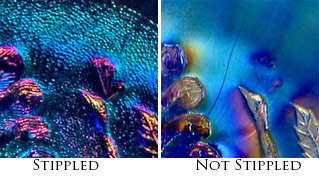Dugan and Diamond Baskets
By Dr. Larry Keig
Dugan was king when it came to carnival baskets. The Dugans, Thomas and Alfred, were masters when it came to concept, craftsmanship, and color. Diamond’s were rarely of the same high quality.
All known carnival baskets produced by one company or by both are described and illustrated here. Some are generously-sized, others mid-sized, the remainder small. Stretch glass baskets without a carnival name are not included. Neither are baskets in which a carnival bowl is set within a metal frame. The baskets covered in the narrative below are:
- Band
- Beaded Basket
- Big Basketweave (two sizes)
- Caroline
- Heavy Web
- Single Flower
- Ski Star
- Smooth Rays with Jeweled Heart exterior
- Smooth Rays with Plain exterior
- Stippled Petals
- Stork and Rushes
- Tree of Life
Dugan’s Generously-Sized
The Dugan large (or generously-sized) baskets are line-item derivatives made from banana-shaped bowls in five well-known patterns. In carnival parlance, a banana shape is one in which two opposite sides have been pulled in. It is at these drawn-in points where the looped handle has been fused. The handle is, in nearly all instances a clear crystal.
It is not uncommon to find cracking where the handle was attached to the bowl. This may, of course, have occurred through accident at some point over the years. However, it was more likely to have been induced while the glass was made. It must have been quite a skill for glassmakers to know exactly when, during the annealing process, the handle could be fused to the bowl without damage occurring. In general, a cracked handle should not detract all that much from the product, given the lack of quality control in the early twentieth century.
Almost all of these baskets are peach opal in color. They are presented here in order of availability, from the commonest to one that is nearly impossible to come by. Measurements provided below are approximations. Dimensions vary somewhat in how far they were pulled out and squeezed in during production.
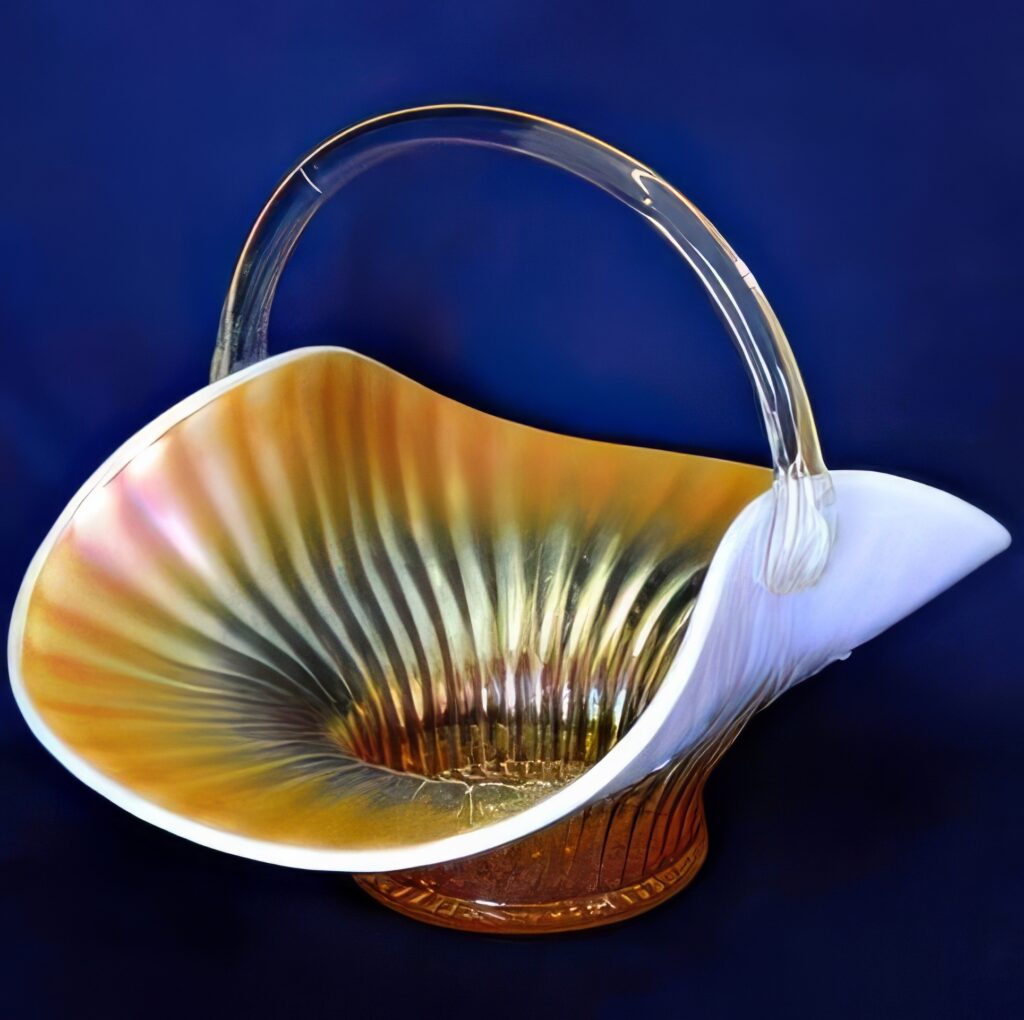
Caroline. Caroline is patterned on both its interior and exterior surfaces. The primary pattern is found on the underside. Its design is non-representational, complex enough as to be nearly indescribable. Outside the intricacy of the elaborate abstract star design are six stylized flowers with button centers and with leafage beneath each. Within the confines of the star, which occupies the rest of the design, are elliptically shaped ornaments placed between each point of the star and other pattern elements which will remain undescribed here. A multi-rayed starred medallion is found in the bottom of the platform base. The interior is made up of 40 thick Smooth Rays which extend to the outer edge. A large sun-rayed star is found on the flat surface of the bottom.
The non-ruffled and non-crimped basket measures approximately nine inches at its widest point. It measures about six and three-fourth inches at the point where the handle is attached. It stands about four inches at its tallest point, not including the handle.
Besides many shapes of bowls in peach opal and in three other colors, the basket has also been confirmed in a light amethyst opal as well as the peach. The peach opal baskets vary in color quality. Some have a dark marigold overlay. Others are considerably lighter. None appear to have been blessed with much in the way of iridescence. The amethyst opal basket that sold on a Tampa Bay convention auction a few years back had hideous color.
Single Flower. Single Flower bowls and baskets are patterned only on their exteriors. Their interiors are plain, without molded design. Each section is made up of two fully open five-petaled flowers on wavy stems, two buds, and five interspersed leaves. The pattern on the platform base is made up of three open flowers and nine leaves.
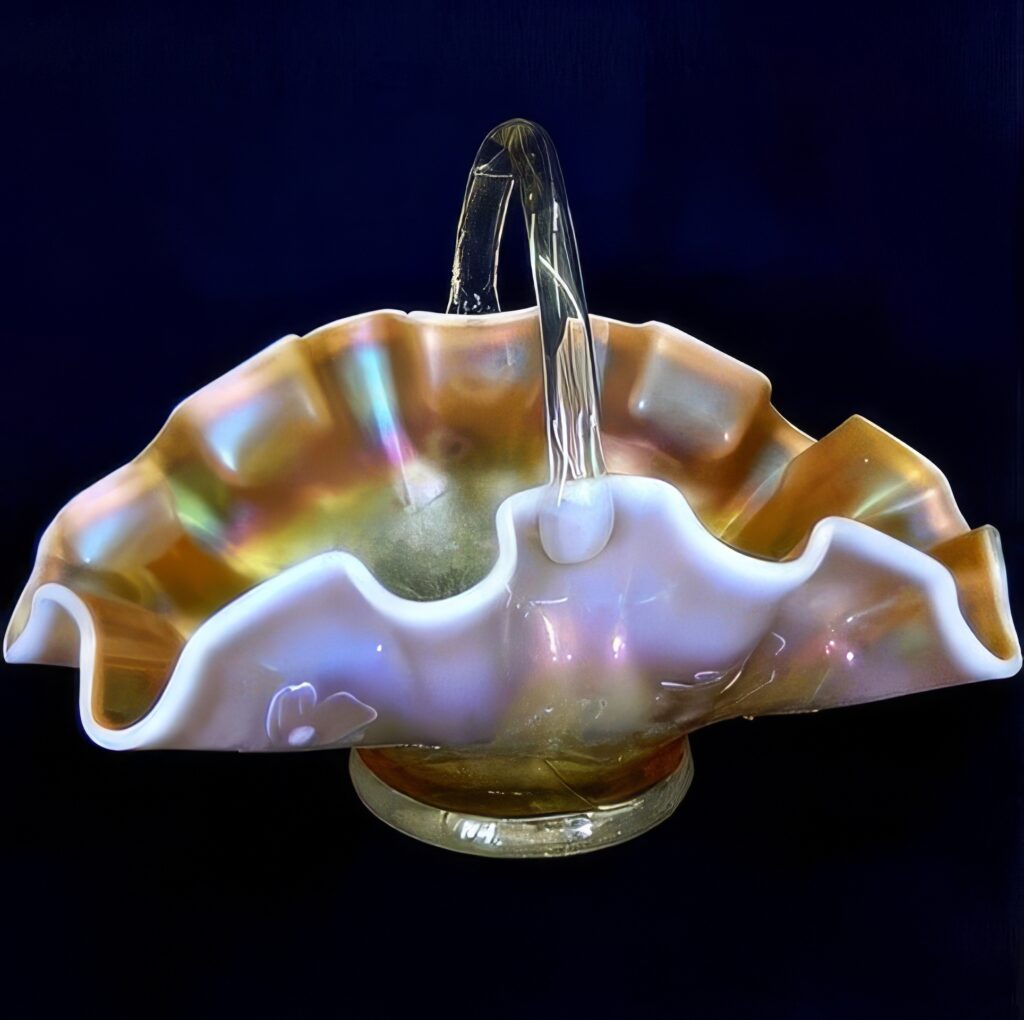
The bowls of the banana-shaped baskets are ten-ruffled. They measure about nine inches at their longest point and approximately seven inches where the handle is attached. At their tallest point, discounting handle, they stand about four and one-half inches tall.
While bowls have been reported in amethyst as well as peach opal and in several shapes, baskets have been reported only in peach opal. Some interiors of baskets have satin (flat) finishes. The interior of others have radium (shiny) tops.
Most Single Flower baskets have clear crystal handles. However, at least one is a frosty translucent. It is shown in the HoC database. One with what appears to have an opalescent handle is (or was once) shown on the Carnival Glass 101 website, but it’s a tenuous proposition to say for sure that its handle is opalized.
Baskets differ significantly in color quality. Some have a dark surface color. Others are much lighter. They are also variable in the amount of opal on their exteriors. Some have opalescence that covers the entire exterior surface. Others have opalescence only around the outer edge.
Ski Star. Ski Star’s interior is comprised of two stippled eight-point stars, each formed from interlocking waning crescents. One is massive, subsuming most of the elevated outer expanse. The other. diminutive in size, is placed dead-center in the bottom.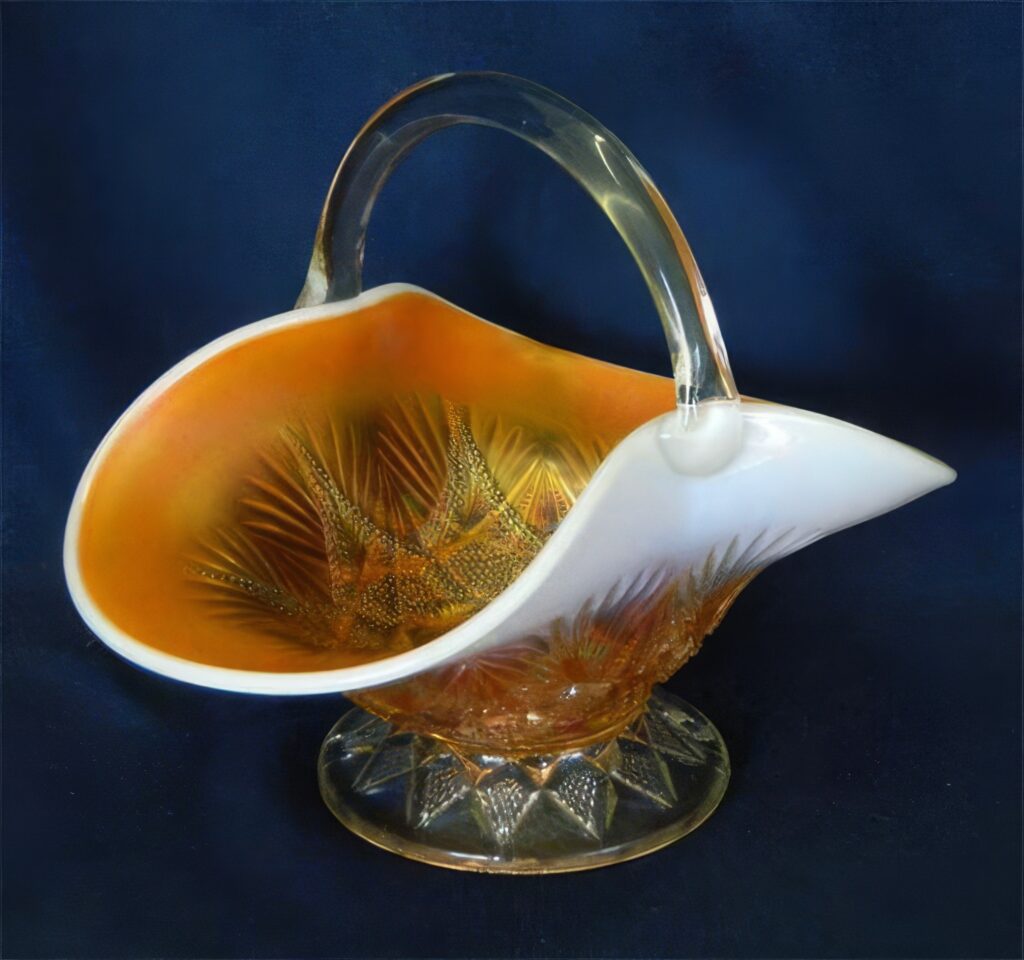
The exterior of all standard-size Ski Star items, of which the basket is one, is Compass. It is a striking geometric that looks like it was sculpted and polished from marble. Ski Star backs are hardly ever iridized.
While large and small Ski Star bowls come with collar as well as dome bases, all authenticated baskets are dome-based. The top of the dome base is unpatterned. Most of the underside is made up of a 24-point star. Inside it is a small sun-rayed medallion.
The banana shape bowls of baskets are non-ruffled and non-crimped. The bowls measure about eight inches at their longest point, five and one-half inches at their narrowest. Bowls of baskets are about four inches tall, not including the looped handle.
All standard-size Ski Star baskets are peach opal, and all have a clear crystal looped handle. The surface color ranges from a bright orange to a relatively light peach. The iridescence ranges from little more than the applied surface color to a glistening (“morning star”) interior that is unique to Dugan’s most striking peach opal.
Outside the patterned area of bowls and baskets with the morning star iridescent treatment is a generous band with multicolor pastel iridescence. Most transfixing, however, are two striking features: (a) the luminous lemon (not gold) iridescence that enshrouds the large dominant star and (b) the juxtaposition of two contrasting surface textures: satin where multicolored, radium where brightly shines the morning star.
Stippled Petals. Stippled Petals baskets are ten-ruffled. The interior pattern is made up of a single large stylized flower and a good-sized ornament in the bottom. The twelve stippled petals are alternately large and small. It’s a simple, not unattractive but inelegant design.
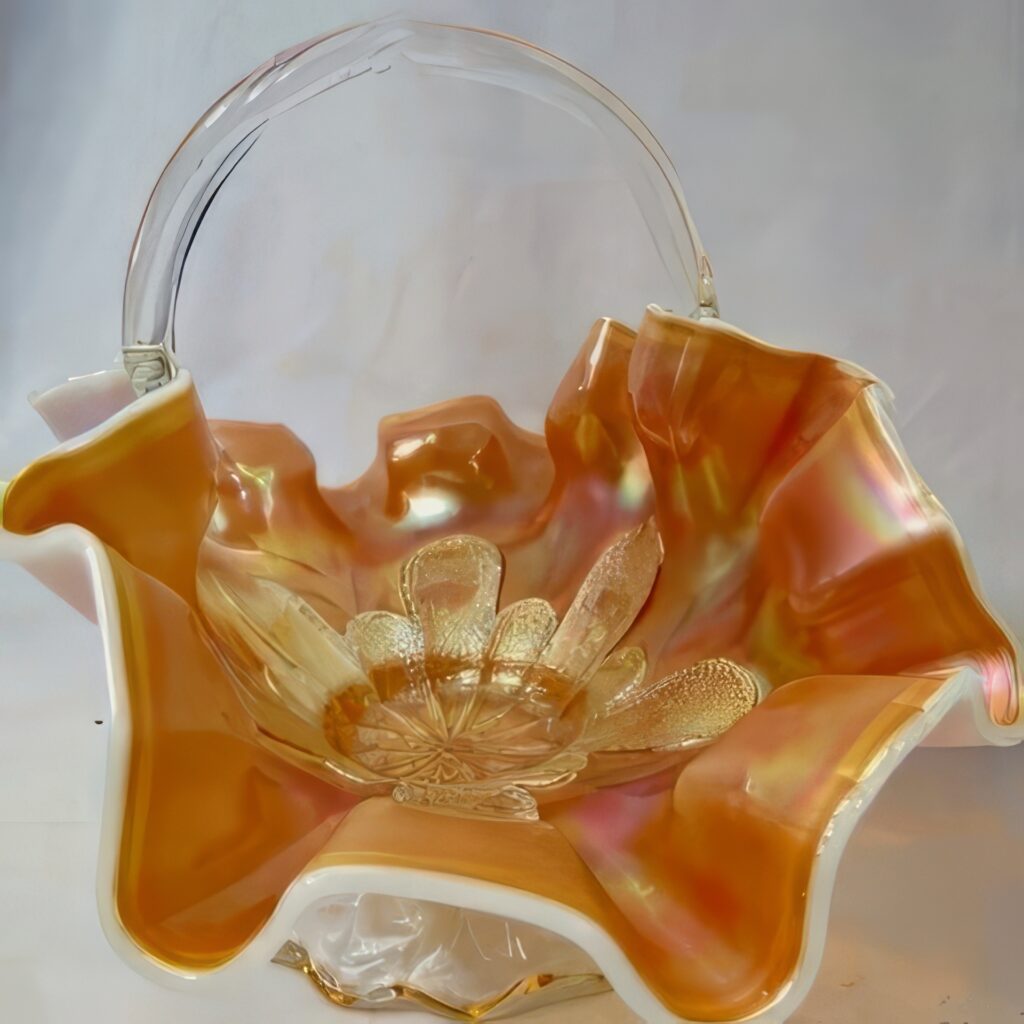
The exterior pattern is Long Leaf, a hold-over from the factory’s pre-carnival era. It is made up of eight only slightly embossed broad leaves which extend upward from the ring that connects the bowl to the dome base and then to within about a half inch of the upper edge.
The lower edge of the dome base is scalloped. Its top surface is plain, without pattern. The angled underside is patterned with a compacted version of the Long Leaf exterior of the basket. There are 12 leaves, one for each of the scallops. It’s an impressive design, one that would have made for an attractive primary or secondary pattern. The flat surface of the base is plain.
At their longest point, the containers of these baskets measure about eight and one-fourth inches, at their narrowest five inches. They stand around four and one-half inches tall, not including the wrap around handle. The surface color and iridescence on the few known vary, with some prettier than others.
Heavy Web. If there were state fair competitions in the category of carnival baskets, Heavy Web would easily bring home the grand prize purple ribbon. This basket is the largest of Dugan’s generously-sized baskets. The shape was configured from the same mold from which chop plates and large bowls were produced, not from molds used to manufacture standard-size bowls, plates, and the other baskets mentioned above.
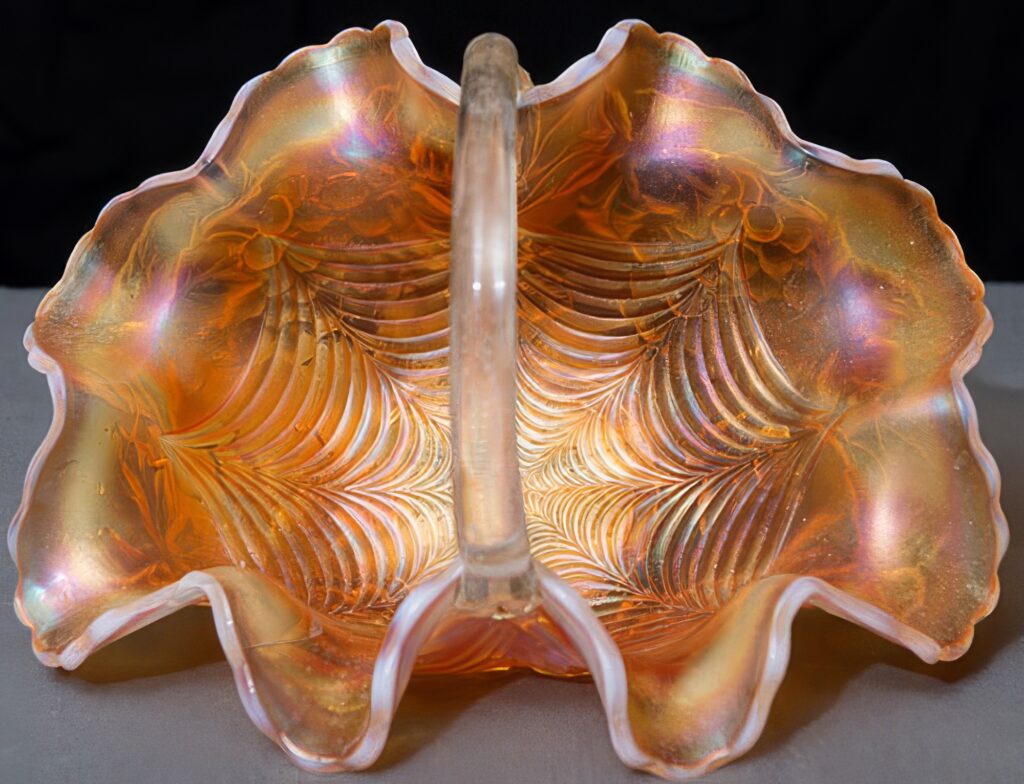
This is the basket that had been in the Larry Sr. and Mary Helen Yung collection for decades. It is now in the collection of the next generation of Yungs.
Heavy Web is a bold design, immediately recognizable even from a first viewing. The huge cobweb (or drape, the alternative Dave Doty suggested) covers the main part of the interior. The remainder, essentially the area within the ruffles, is plain.
For some inexplicable reason, two dissimilar patterns – Grape Clusters and Morning Glory, both intaglio designs – are found on Heavy Web exteriors. Both are unique to this primary pattern. The basket described and illustrated here has the Grape Cluster secondary. The back pattern of others, few in number, is currently unknown. No need to describe these patterns further as, well, one has fruit, the other flowers.
Bowls of the banana shape baskets are eight-ruffled, unlike the other generously-sized ruffled baskets, both of which have ten. Fully extended across ruffles, they are about 12 inches long and a bit over five inches wide, not including the thickness of the handle. They stand four and one-half inches at their tallest point. All have a serrated (sawtooth) top edge. They rest on a ground base. A grape cluster is pressed into the bottom of the base.
Dugan’s and Diamond’s Mid-Size
The five mid-size baskets are somewhat smaller than the large but not tiny. The two Smooth Rays were made between 1909 and 1913 while the Dugans were operating the Indiana, Pennsylvania, plant. The larger of the Big Basketweave and the Beaded Basket were made during this same time frame and then also by Diamond after the plant was bought out and the name of the plant was changed. The Stork and Rushes was produced solely during the Diamond era (1913-1931), probably in the mid- to late-teens.
Smooth Rays with Jeweled Heart Exterior. Telling the difference between the Dugan peach opal Smooth Rays baskets is easy. One has a back pattern. The other doesn’t. One has a serrated and tightly crimped outer edge. The edge of the other is a smooth non-crimped. One is available in some quantity. The other has been, until recently, virtually unknown.
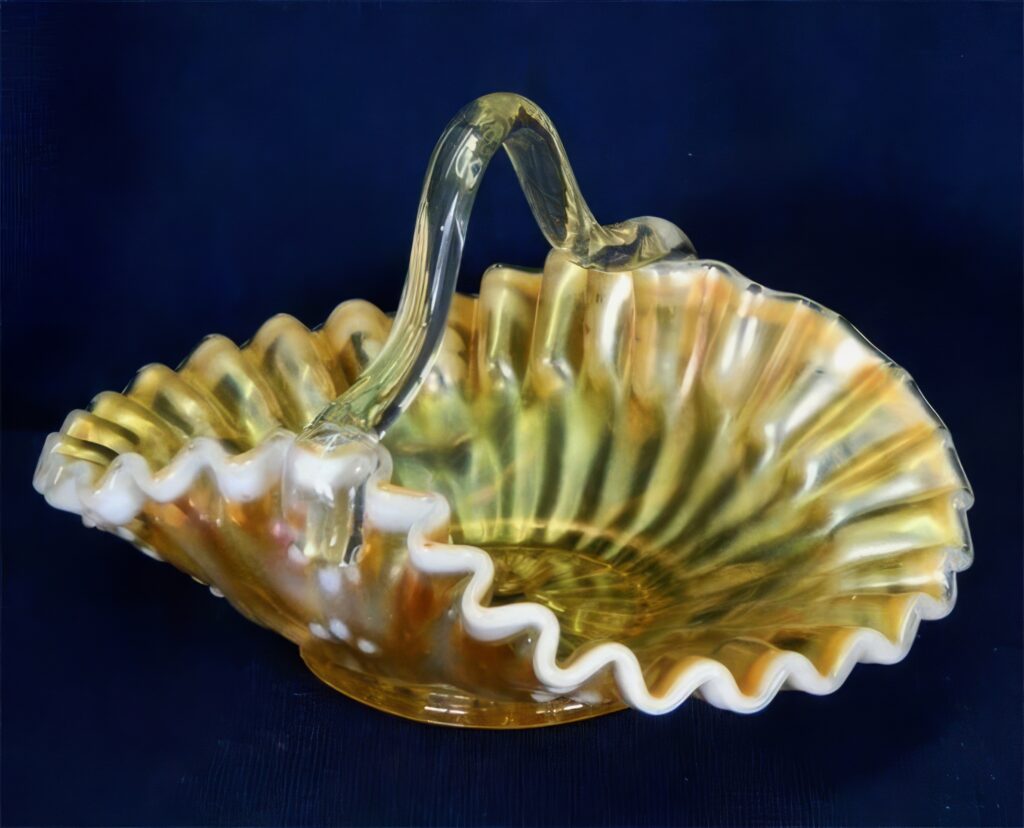
The 28 rays on the S.R./J.H. interior emanate at the outer edge and occupy all the elevated surface. The flat surface just above the collar base is plain. The Jeweled Heart exterior is an elegant pattern covering the entirety of the sides but difficult to see when camouflaged by opalescence. The underside of the base is sun-rayed. The top edge is crimped and serrated. The handle bonded to the container is essentially an inverted V dipole, a shape unique to Smooth Rays baskets. However, they are not sui generis to Dugan carnival as they are also found on Dugan pre-carnival baskets.
Smooth Rays/J.H. baskets are more variable in size than the others. On average, though, they measure about six and one-half inches long, four and one-half inches wide, and stand two-plus inches tall. They are an attractive shape but rarely flush with rich surface color or iridescence. They are much more available than the Smooth Rays/Plain.
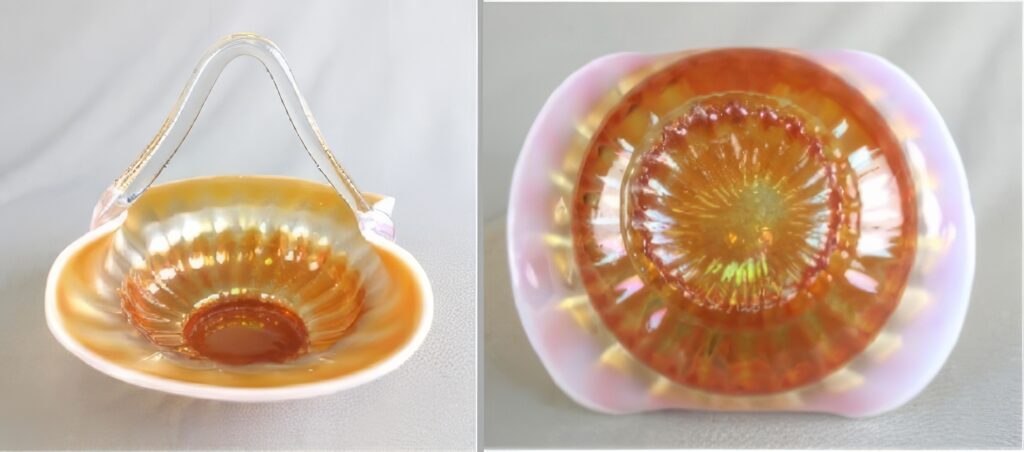
Smooth Rays/Plain. Like Smooth Rays/Jeweled Heart, the Smooth Rays/Plain is a peach opal banana shape to which a separate clear crystal handle was attached when the basket was made. Its 22 rays run from about three-fourth of an inch from the outer edge to the bottom of the elevated sides. Only the flat area above the collar base is left unpatterned. The exterior is not patterned at all. The area on which the basket rests has an ornamental medallion pressed into its surface. The outer edge of the container is smooth and non-crimped. The handle is, like the S.R./J.H., an inverted V dipole.
In size the S.R./Plain is slightly smaller than the S.R./J.H. It is about six inches long and four inches wide and is approximately two and one-half inches tall.
The Smooth Rays/Plain basket is rare, with only a couple having been reported. One is owned by Gary Sullivan and Steve Lindquist who bought it a few years back from Mike Soper at a Hagerstown, Maryland, carnival event. Another sold at Hagerstown in October 2019. There must be others yet to be accounted for. Even with so few available, they are not, of course, anywhere near the top rung on the desirability ladder.
Big Basketweave with Unpatterned Looped Handle. Big Basketweave baskets come in two sizes. One is a mid-size with an unpatterned clear crystal looped handle. The other is tiny in size, it has an arched clear crystal handle with a rope-like design on it.
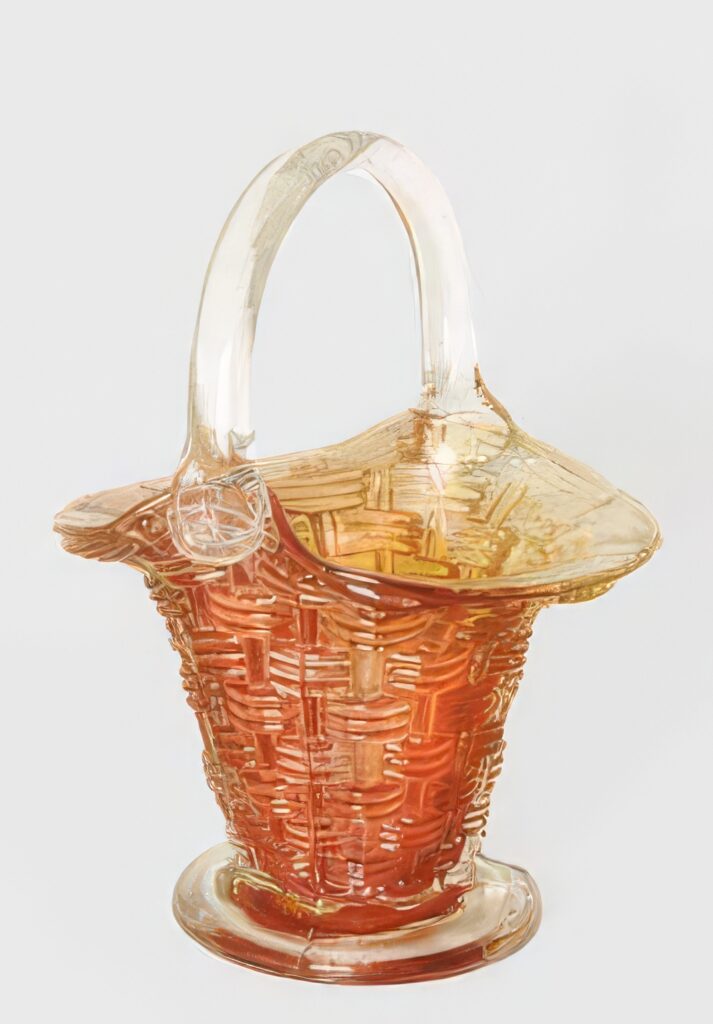
The exterior of the relatively heavy mid-size is a deeply cut crosshatched design that covers the surface of the container top to bottom. This unitary design distinguishes it from the tripartite Beaded Basket pattern with which it is often confused. The interior and underside of the base are plain.
The height of the holder, without handle, is three and three-fourth inches. The banana-shaped body is five and one-fourth inches long and three inches wide.
Big Basketweave baskets were likely introduced by Dugan not long before the plant changed ownership in July 1913, that conclusion based on the fact that nearly all baskets are marigold, a scarce Dugan color but quotidian in Diamond. Production continued on and off throughout the Diamond years, until at least 1929.
Nearly all mid-size Big Basketweave baskets are marigold. The base of most is clear but the color on some covers the bottom as well as the sides creating an amber effect. The base color of at least one is a very light amethyst. It has a marigold overlay so is a shade of amethyst, not a lavender.
It’s a shame, but not surprising, that these come in such a limited range of colors. That’s probably because as soon as the plant changed hands the new owners began to cut corners in order to cut costs.
A mid-size Big Basketweave basket of another sort is also available. Radium inside and out, it has no handle. Or perhaps it’s just a one-of-a-kind odd-shaped banana bowl.
Beaded Basket. Compared to other baskets made by Dugan and Diamond, the Beaded Basket is the most realistically designed. It actually looks like the iconic wicker laundry baskets of old. It is also impressive because its pattern elements are proportionately raised above the surface of the container.
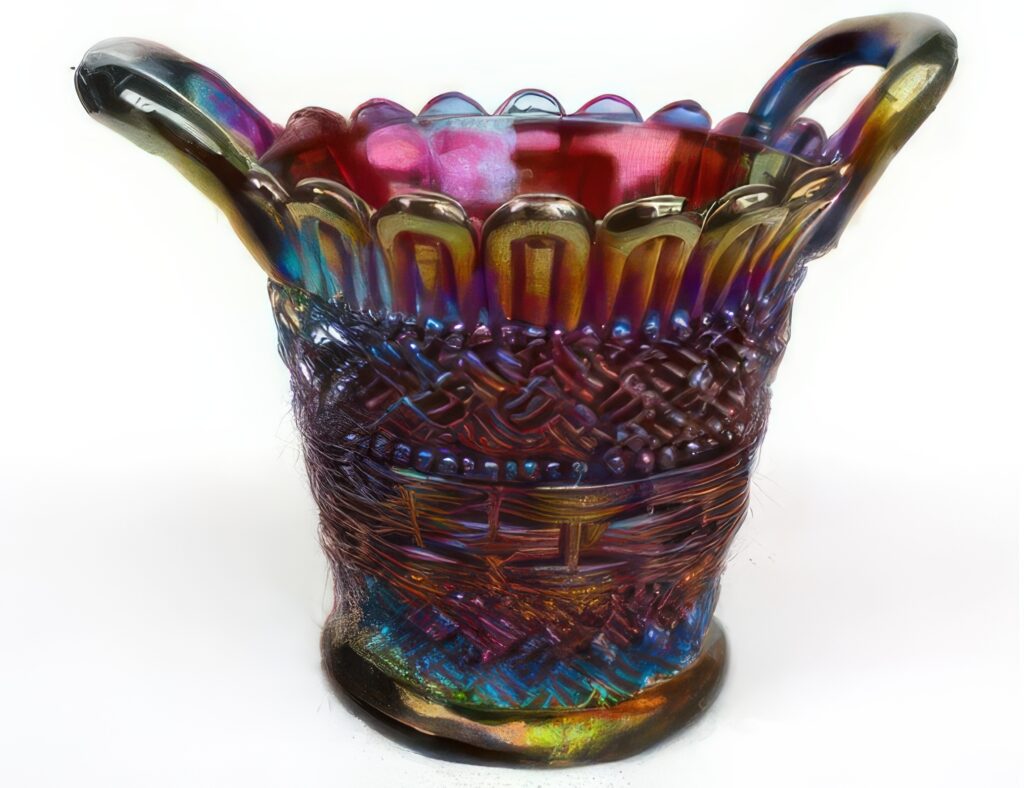
The principal elements, which occupy most of the exterior, are three bands of basketry. The center band has a horizontal weave. The bands above and below that have diagonal weaving. Atop the rows of basketweave is a band of inverted parabolas which extend to a scalloped top edge. Two molded handles, one across from the other, are attached to these upside down arches. The interior and underside of the collar base are unpatterned.
Handles of Dugan and Diamond Beaded Baskets are configured in two different ways. Some have flared handles. The handles of others are straight up. These handle variations coincide with which owner was operating the plant at the time the basket was produced.
Dugan made the Beaded Basket with flared handles. They are available in two shades of black amethyst, a traditional amethyst, white, and, occasionally, marigold. Diamond manufactured those with straight-up handles. They come in marigold, amethyst, blue, aqua and/or sapphire, marigold over pink, marigold over lime green, and, possibly, white.
An expansive article on the Beaded Basket appeared in the June 2024 issue of The Carnival Pump. It is also available on the Hooked on Carnival site.
Stork and Rushes. Stork and Rushes is an attractive pattern, one of Diamond’s most pleasing designs. It was made in two versions. One has beaded bands encircling areas near the top and the bottom. The other has a lattice band wrapped around an area not far from the rim. All reported baskets have the lattice band.
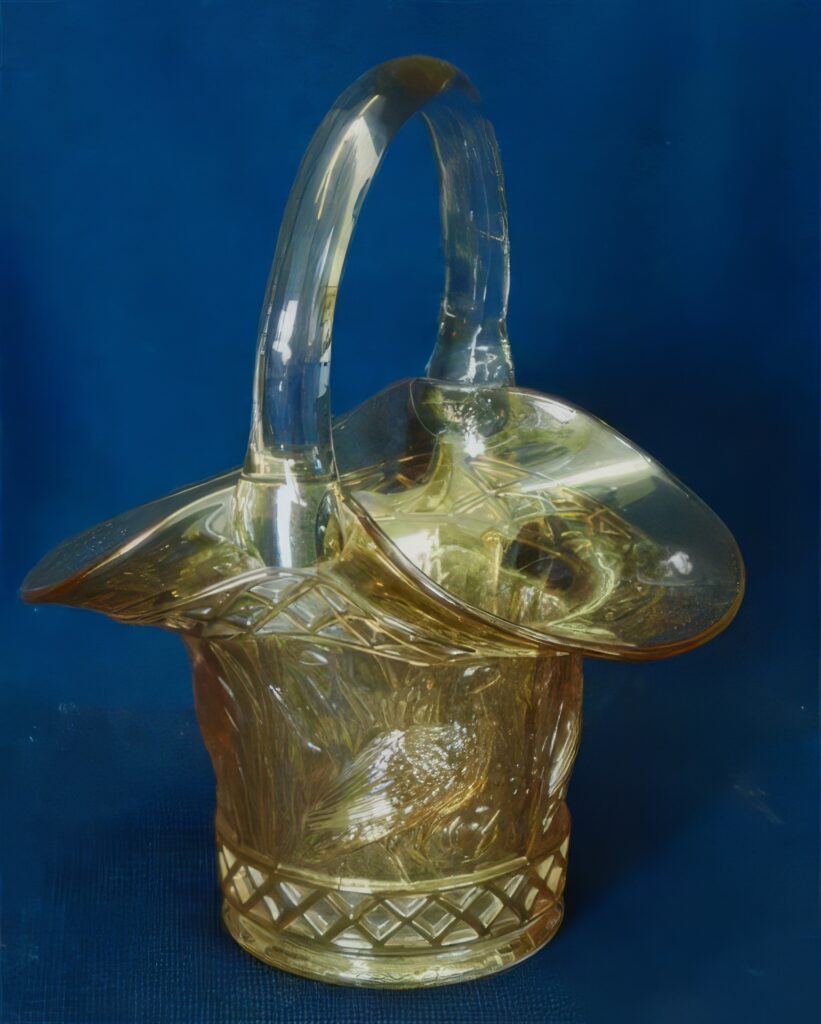
Baskets are line-item derivatives made from what would otherwise have been tumblers. They feature four storks positioned around the banana shape exterior. Beneath, between, and behind the birds are “rushes,” grass-like plants that typically grow in wetlands, a natural habitat for storks and other aquatic fowl. At the feet of a couple of the birds are dense brambly shrubs. A looped clear crystal handle is bonded to the area of the basket that is pulled in. The interior and base of the basket are unpatterned.
All reported baskets are a light marigold. None of those pictured on the HoC pricing database have much in the way of iridescence. This reality is but one more indicator that soon after new management took over what was to become the Diamond Glass Company color quality was a casualty of efforts to reduce costs while, at the same time, bolster profits or, at minimum, mitigate a precarious financial situation.
Diamond’s Small
The three small carnival baskets made at the southwest Pennsylvania glassmaking plant are Diamond products. None are particularly imaginative in design.
Band. Diamond’s Band is a simple pattern, inside and out. Sometimes called Optic Rib and Band, it has concave “optic” ribs on the interior. The pattern comes with two exterior subtypes: (a) one with two raised bands with no patterning between them near the top and (b) the other with lattice crosshatching between the bands. The latter is slightly dressier than the other. The bands, filled or not, are the only exterior design element.
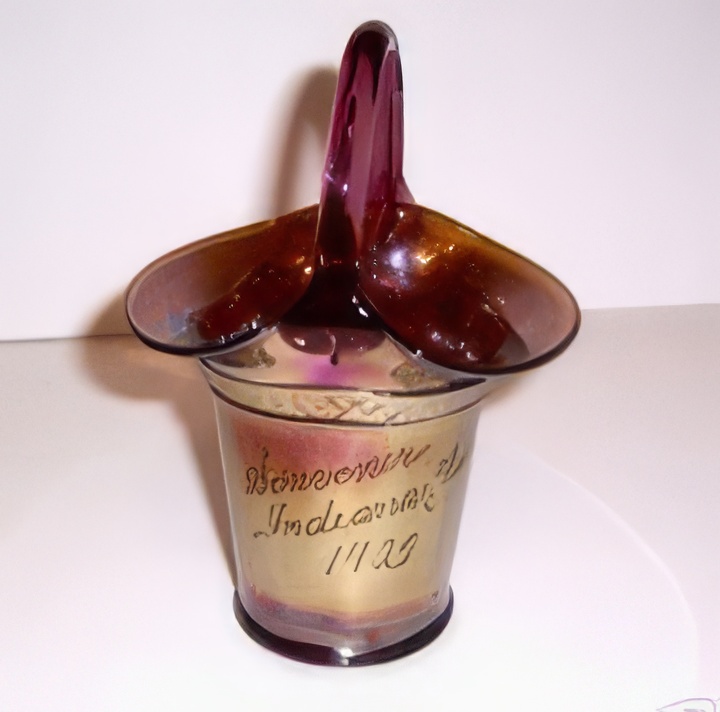
The baskets are banana-shape hats with a clear crystal handle which was bonded to them while the glass was in a semi-malleable state. Hats are awkward looking, the baskets a charming “small.”. Hats aren’t hard to find. The baskets are scarce but won’t break the bank if you’d like and can find one.
The container is about three inches long and two inches wide where the handle is attached. They are about six inches tall, including handle. They have a base diameter of approximately two and one-half inches. The base is unpatterned.
They are available in marigold and amethyst in about equal amounts. Some have hand-written souvenir lettering, most of those with “Indiana Fair” scripting. The fair was an annual event in the small southwest Pennsylvania town where the glassmaking plant operated.
Big Basketweave with Roped Handle. The little Big Basketweave basket is about as unpretentious and undistinguished as carnival gets. They must have been made and mass marketed in great quantities, quite likely for utilitarian purposes.
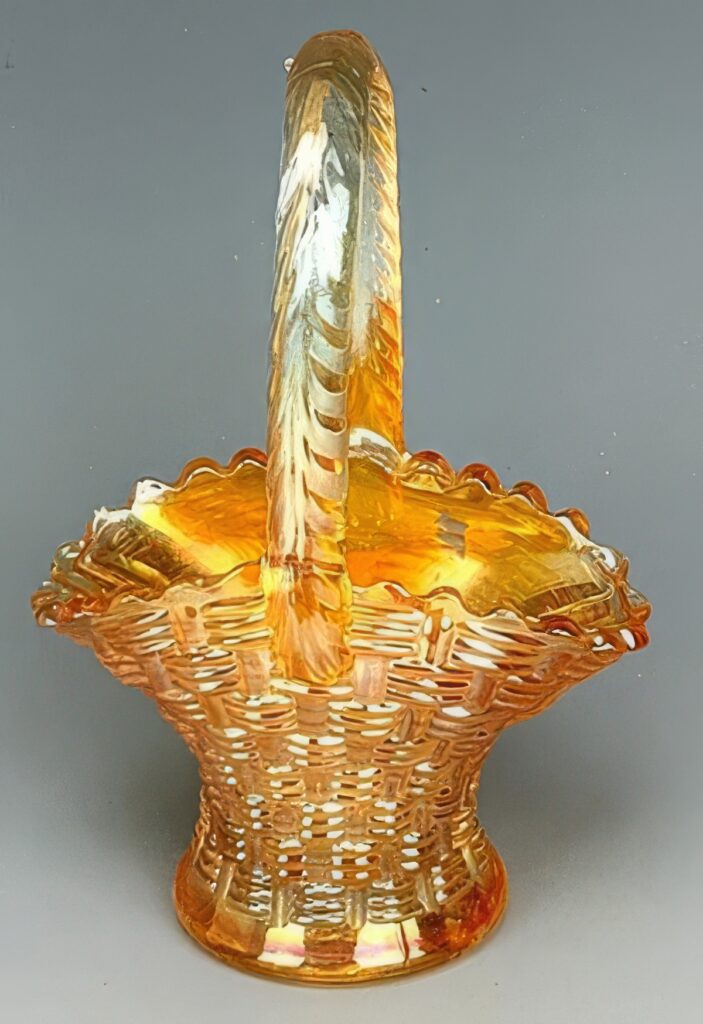
A fascinating anecdote is provided on the Big Basketweave page of the HoC pricing database. It reads: “A small basket sold at auction containing information stating that it sold in 1923, it was filled with candy corn and the going price at that time was 10 cents.” This may mean that these little baskets were wholesale to confectioners who filled them with goodies and then marketed them to retailers like “five and dimes. Or a store owner may have bought the baskets wholesale and filled them with sweets from their own candy counters.
Made from a different mold than the large, the small basket, with a tall rope-like clear crystal handle, is six inches tall. The holder, without handle, is two and three-eighth inches tall. The banana-shaped bowl is three and one-half inches long, two inches wide. Its base, with a star pressed into its underside, is two inches in diameter.
Marigold is the only color that has been reported in carnival. Surface color ranges from weak to robust. Light or dark, they hardly ever display much in the way of iridescent coloring.
Tree of Life. The tiny Tree of Life basket looks like it has been dropped and ruinously cracked but somehow remained unshattered. It is different from the patterns called Soda Gold and Crackle. Tree of Life has no stippling on its exterior. The other two are stippled everywhere except where “cracked.” Tree of Life’s interior is plain.
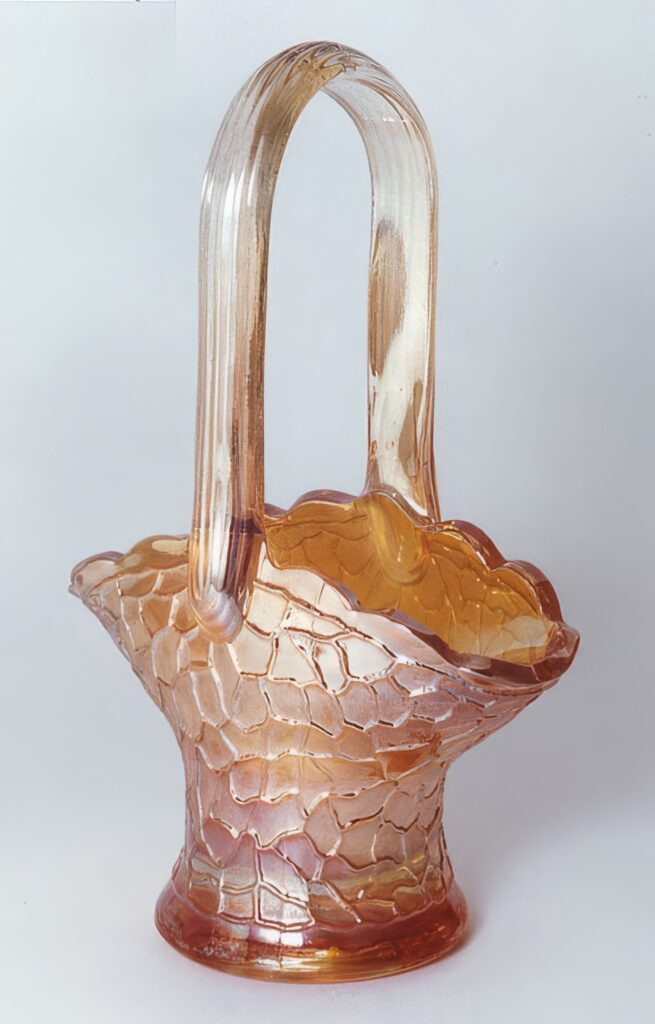
Like most other Dugan and Diamond baskets, its container is banana-shaped. It has an arched clear crystal handle. The container is about three inches long and two inches wide at the point where the handle is attached. The ridged handle is as tall, or taller than, the basket. The basket stands about six inches tall from base to top of handle. Its two and one-half inch base is unpatterned. These baskets have been confirmed only in marigold in carnival. They are highly variable in quality of color. Most have a fairly flat surface color but a few are a bit more vibrant.
Larry.Keig@cfu.net
This article first appeared in the ICGA Pump in the December 2024 issue and is reprinted with permission.
Thanks to Scott & Suzanne Sheffield and Rick & Debbie Graham for the use of their photos.

